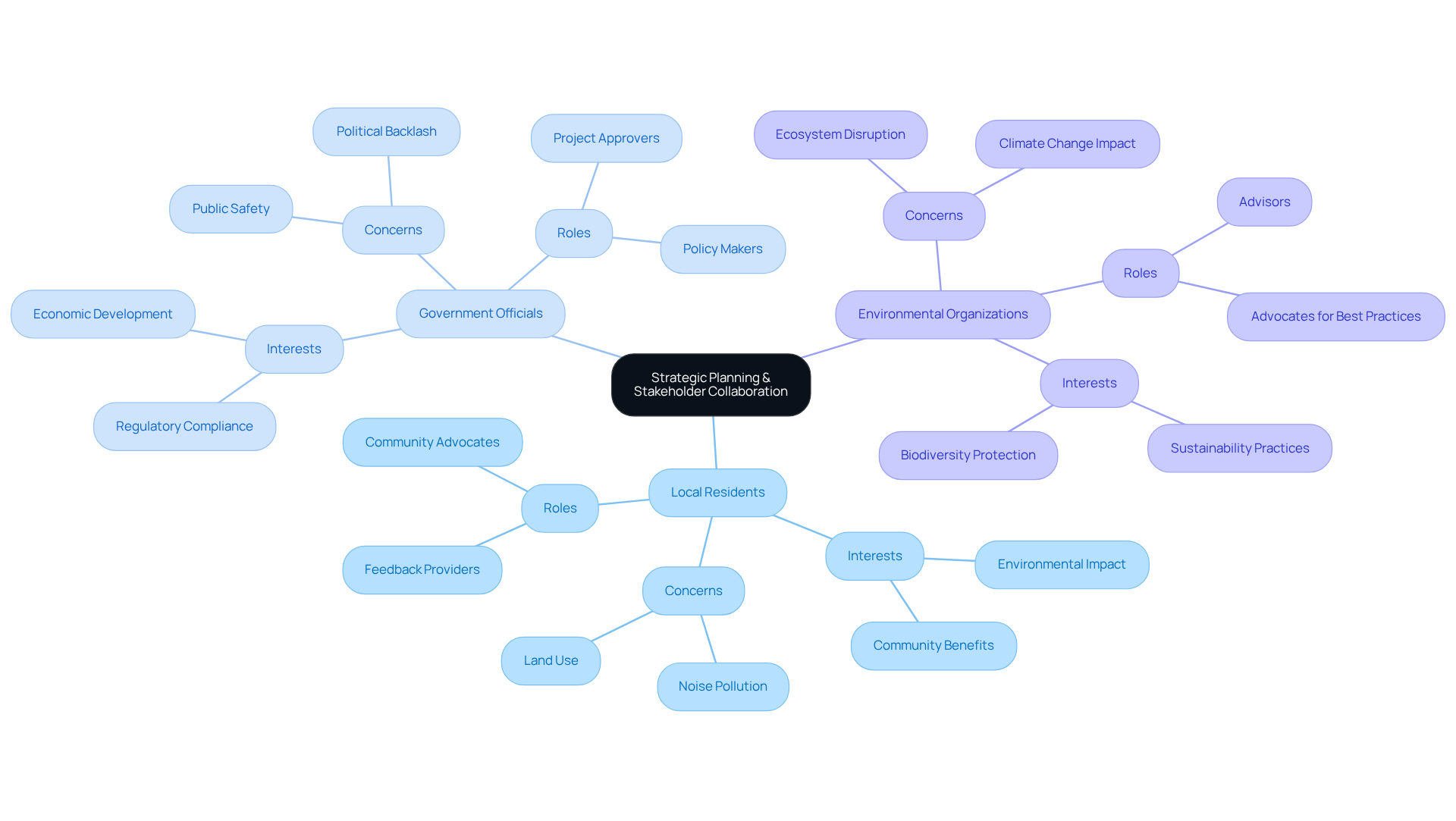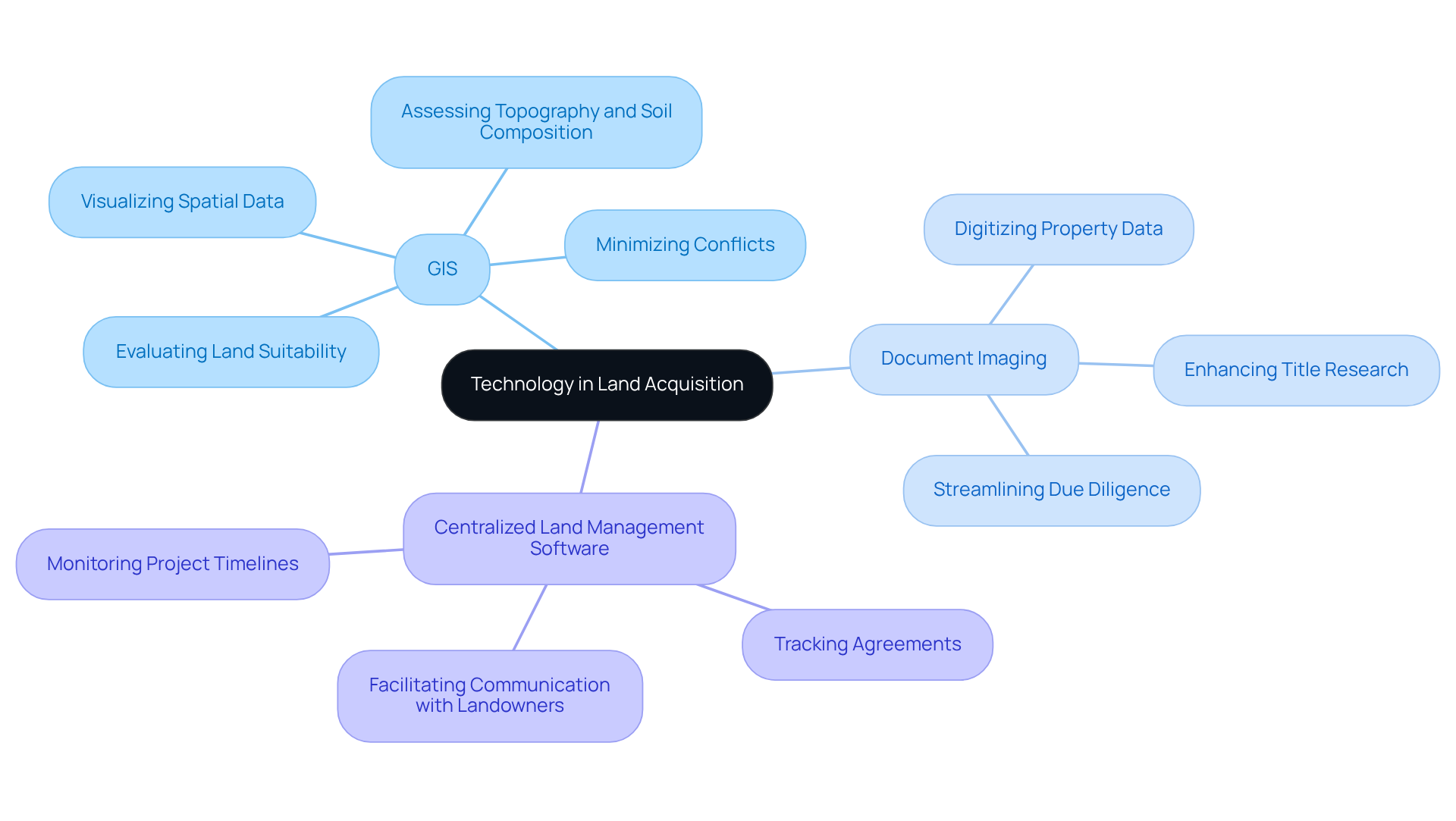Overview
The article addresses the significant challenges and strategies associated with land acquisition for community-backed wind projects. Navigating these complexities is no small feat; it requires robust community engagement, strategic planning, and the effective application of technology. These elements collectively enhance both project feasibility and sustainability. Notably, statistical evidence demonstrates marked improvements in project success rates and completion times when local stakeholders are actively involved. This underscores the critical role that community participation plays in achieving successful outcomes.
Introduction
Community-backed wind projects are emerging as a transformative force in the renewable energy landscape, where local stakeholders actively engage in ownership and management. These initiatives not only strengthen community ties but also enhance project viability, showcasing the profound benefits of collective engagement.
However, the path to successful land acquisition for these projects is fraught with legal and regulatory hurdles that can challenge even the most well-intentioned efforts.
How can developers effectively navigate these complexities while fostering community support and ensuring sustainable outcomes?
Define Community-Backed Wind Projects and Their Importance
Community-backed wind projects represent a vital strategy in which regional stakeholders, including residents and businesses, actively participate in the ownership and management of wind energy facilities. These initiatives underscore the significance of regional leadership and funding, fostering a strong sense of community ownership. Their importance is evident in their ability to bolster regional support, enhance the feasibility of initiatives, and ensure that economic benefits remain within the community.
By aligning the interests of developers with those of local residents, community-supported initiatives effectively mitigate opposition and streamline the permitting process. This alignment not only facilitates smoother implementation but also contributes to higher success rates. Studies reveal that projects with robust community involvement are completed 20% faster and achieve an 85% completion rate, compared to only 65% for those with minimal engagement, as reported by the World Bank.
Furthermore, community-supported initiatives frequently demonstrate a 30% greater likelihood of sustainability over five years, according to observations by the Overseas Development Institute. This highlights the long-term advantages of community engagement. Successful examples, such as Germany's community-backed wind projects, illustrate how community ownership can drive significant advancements in renewable energy deployment, with over half of the nation’s onshore renewable capacity now under community-backed wind projects.
Engaging regional stakeholders not only enhances the outcomes of initiatives but also fosters a collaborative environment that promotes the broader objectives of renewable energy advancement. As emphasized by the International Association for Public Participation, initiatives characterized by strong public engagement processes face considerably fewer instances of public resistance and legal disputes.

Navigate Legal and Regulatory Requirements for Land Acquisition
Navigating the legal and regulatory landscape for land acquisition in community-backed wind projects presents numerous challenges. Developers must first identify the pertinent local, state, and federal regulations, including zoning laws, environmental assessments, and permitting processes. Engaging legal specialists early in the initiative is essential to clarify these requirements and ensure compliance. Furthermore, establishing clear communication channels with regulatory bodies facilitates a smoother approval process.
Thorough due diligence on land titles and rights is non-negotiable, as it ensures that all legal aspects are meticulously addressed before proceeding with acquisition. Harbinger Land's efficient document imaging solutions significantly streamline the title research and leasing process. By providing developers with quick access to essential property data, these solutions mitigate risks associated with legal disputes, thus preventing costly delays and enhancing the likelihood of success.
As we approach 2025, it is important to recognize that many landowners remain apprehensive about energy farm leases. This reality underscores the necessity for effective outreach and education regarding the benefits of renewable energy initiatives. Understanding the evolving framework of zoning laws and environmental regulations will empower developers to tackle these challenges effectively, ensuring that community-backed wind projects and other renewable energy initiatives progress seamlessly.

Implement Strategic Planning and Stakeholder Collaboration
Implementing strategic planning in community-backed wind projects requires a thorough identification of essential participants, including local residents, government officials, and environmental organizations. Understanding their interests and concerns is crucial for fostering collaboration. By involving interested parties early in the process, valuable input is collected, and a sense of ownership is cultivated among community members. Regular meetings, surveys, and public forums serve as effective means of open communication and transparency, ensuring that participants feel acknowledged and valued.
A well-organized engagement strategy is vital, outlining how input will be integrated into decisions related to the initiative. This approach builds trust and cooperation, leading to stronger support networks necessary for the initiative's long-term success. Statistics reveal that initiatives with effective participant management are 2.5 times more likely to succeed, and those with high participant involvement can achieve success rates of up to 70%. Furthermore, companies that engage with their community are 50% more likely to meet their major objectives, underscoring the tangible benefits of aligning initiative goals with community values.
Case studies, such as Interface's commitment to sustainability, illustrate that organizations prioritizing collaboration with stakeholders experience shorter delivery times and increased community satisfaction. By leveraging local insights, developers can mitigate potential conflicts and enhance the viability of their initiatives. Successful engagement strategies, including tailored communication and proactive issue resolution, are essential for navigating the complexities of land acquisition in community-backed wind projects. Notably, 85% of successful initiatives center around strong stakeholder engagement, emphasizing the critical role of stakeholder involvement in achieving success.

Leverage Technology for Efficient Land Acquisition
Employing advanced technology in land acquisition for community-backed wind projects significantly enhances efficiency and effectiveness. Geographic Information Systems (GIS) are crucial in evaluating land suitability, identifying potential locations, and visualizing spatial data associated with energy resources and environmental limitations. This technology enables developers to conduct thorough analyses that consider factors such as topography and soil composition, ensuring informed decision-making.
Moreover, Harbinger Land's efficient document imaging solutions enhance title research by digitizing property data, allowing title agents to complete their research and leasing processes more efficiently and cost-effectively. By deploying imaging agents to courthouses or acquiring documents through records requests, Harbinger Land can quickly obtain large datasets, streamlining due diligence efforts and increasing accuracy in identifying ownership and easements.
The integration of centralized land management software further facilitates communication with landowners, enabling effective tracking of agreements and negotiations. By merging GIS and Harbinger Land's document imaging services, developers can enhance workflows, reduce risks, and ensure that land acquisition processes are carried out effectively and within timelines. This technological synergy not only supports the successful implementation of community-backed wind projects but also contributes to the broader goal of advancing renewable energy initiatives.

Conclusion
Community-backed wind projects represent a transformative approach to renewable energy, emphasizing the essential role of local stakeholders in the development and management of wind facilities. By fostering community ownership, these projects not only enhance local support but also ensure that the economic benefits are retained within the community. This alignment between developers and residents is vital for overcoming challenges and streamlining the implementation process, ultimately leading to higher success rates and sustainability for renewable energy initiatives.
The effectiveness of community-backed wind projects hinges on several critical elements:
- Navigating legal and regulatory frameworks for land acquisition is paramount.
- The necessity of strategic planning and stakeholder collaboration.
- Engaging local residents and stakeholders from the outset cultivates a sense of ownership and mitigates potential conflicts, leading to more successful outcomes.
- Leveraging advanced technologies like GIS and document imaging significantly improves the land acquisition process, ensuring timely and compliant project execution.
Ultimately, the significance of community-backed wind projects extends beyond local energy production; they embody a collaborative effort toward a sustainable future. By prioritizing community engagement and leveraging technology, stakeholders can navigate the complexities of land acquisition and regulatory requirements more effectively. As the demand for renewable energy continues to grow, embracing these practices will be crucial for fostering successful initiatives and achieving broader environmental goals. Engaging in community-backed projects not only empowers local residents but also paves the way for a cleaner, more sustainable energy landscape.
Frequently Asked Questions
What are community-backed wind projects?
Community-backed wind projects are initiatives where regional stakeholders, including residents and businesses, actively participate in the ownership and management of wind energy facilities.
Why are community-backed wind projects important?
They are important because they foster regional leadership and funding, enhance community ownership, bolster regional support, improve the feasibility of initiatives, and ensure that economic benefits remain within the community.
How do community-supported initiatives affect project implementation?
By aligning the interests of developers with local residents, community-supported initiatives mitigate opposition and streamline the permitting process, leading to smoother implementation and higher success rates.
What are the completion rates for projects with community involvement compared to those with minimal engagement?
Projects with robust community involvement are completed 20% faster and have an 85% completion rate, while those with minimal engagement only achieve a 65% completion rate.
How does community engagement impact the sustainability of wind projects?
Community-supported initiatives have a 30% greater likelihood of sustainability over five years, indicating the long-term advantages of community engagement.
Can you provide an example of a successful community-backed wind project?
Germany's community-backed wind projects are a successful example, where over half of the nation’s onshore renewable capacity is under community-backed initiatives.
What benefits do regional stakeholder engagements bring to renewable energy initiatives?
Engaging regional stakeholders enhances the outcomes of initiatives and promotes a collaborative environment that supports broader renewable energy objectives, while also reducing public resistance and legal disputes.
List of Sources
- Define Community-Backed Wind Projects and Their Importance
- What Statistics Indicate Community Involvement's Impact on Project Success? → Question (https://sustainability-directory.com/question/what-statistics-indicate-community-involvements-impact-on-project-success)
- Through Benefits-Sharing Agreements, Clean Energy Projects Can Earn Community Trust (https://wri.org/insights/clean-energy-community-benefits-agreements)
- Price or public participation? Community benefits for onshore wind in Ireland, Denmark, Germany and the United Kingdom (https://sciencedirect.com/science/article/pii/S2214629624001968)
- Navigate Legal and Regulatory Requirements for Land Acquisition
- 20 Quotes To Get You Inspired For a Renewable Future - Solstice (https://solstice.us/solstice-blog/20-quotes-for-a-renewable-future)
- Regional Wind Energy Policy Analysis for Effective Land Acquisition (https://blog.harbingerland.com/regional-wind-energy-policy-analysis-for-effective-land-acquisition)
- 60 Quotes About the Future of Renewable Energy (https://deliberatedirections.com/renewable-energy-quotes)
- Maryland Governor Wes Moore Enacts Key Environmental and Energy Legislation in Spring 2025 Session, Including EPR for Packaging and Solar Permitting Reforms (https://bdlaw.com/publications/maryland-governor-wes-moore-enacts-key-environmental-and-energy-legislation-in-spring-2025-session-including-epr-for-packaging-and-solar-permitting-reforms)
- Implement Strategic Planning and Stakeholder Collaboration
- Why is Stakeholder Management Important: The Key to Project Success and Growth (https://dartai.com/blog/why-is-stakeholder-management-important)
- Project Management Statistics 2024: New Trends | TeamStage (https://teamstage.io/project-management-statistics)
- Stakeholder Engagement Effectiveness Statistics (https://zoetalentsolutions.com/stakeholder-engagement-effectiveness)
- What Statistics Indicate The Impact of Stakeholder Engagement? → Question (https://sustainability-directory.com/question/what-statistics-indicate-the-impact-of-stakeholder-engagement)
- Leverage Technology for Efficient Land Acquisition
- 60 Quotes About the Future of Renewable Energy (https://deliberatedirections.com/renewable-energy-quotes)
- Streamlining Land Acquisition with GIS Services: A Comprehensive Guide (https://blog.harbingerland.com/streamlining-land-acquisition-with-gis-services-a-comprehensive-guide)
- GIS and Cartography Quotes (https://geographyrealm.com/gis-quotes)




